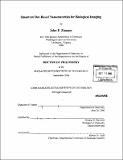| dc.contributor.advisor | Moungi G. Bawendi. | en_US |
| dc.contributor.author | Zimmer, John P. (John Philip) | en_US |
| dc.contributor.other | Massachusetts Institute of Technology. Dept. of Chemistry. | en_US |
| dc.date.accessioned | 2007-07-18T13:04:06Z | |
| dc.date.available | 2007-07-18T13:04:06Z | |
| dc.date.copyright | 2006 | en_US |
| dc.date.issued | 2006 | en_US |
| dc.identifier.uri | http://hdl.handle.net/1721.1/37888 | |
| dc.description | Thesis (Ph. D.)--Massachusetts Institute of Technology, Dept. of Chemistry, 2006. | en_US |
| dc.description | Vita. | en_US |
| dc.description | Includes bibliographical references. | en_US |
| dc.description.abstract | Quantum dot-based fluorescent probes were synthesized and applied to biological imaging in two distinct size regimes: (1) 100-1000 nm and (2) < 10 nm in diameter. The larger diameter range was accessed by doping CdSe/ZnS or CdS/ZnS quantum dots (QDs) into shells grown on the surfaces of pre-formed sub-micron SiO2 microspheres. The smaller diameter range was accessed with two different materials: very small InAs/ZnSe QDs and CdSe/ZnS QDs, each water solubilized with small molecule ligands chosen for their ability not only to stabilize QDs in water but also to minimize the total hydrodynamic size of the QD-ligand conjugates. Indium arsenide QDs were synthesized because nanocrystals of this material can be tuned to fluoresce in the near infrared (NIR) portion of the electromagnetic spectrum, especially in the 700-900 nm window where many tissues in the body absorb and scatter minimally, while maintaining core sizes of 2 nm or less. The QD-containing microspheres were used to image tumor vasculature in living animals, and to generate maps of size-dependent extravasation. With subcutaneously delivered nAs/ZnSe QDs, multiple lymph node mapping was demonstrated in vivo for the first time with nanocrystals. When administered intravenously, < 10 nm QDs escaped from the vasculature, or were efficiently cleared from circulation by the kidney. Both of these behaviors, previously unreported, mark key milestones in the realization of an ideal fluorescent QD probe for imaging specific compartments in vivo. Also presented in this thesis is the growth of single-crystalline cobalt nanorods through the oriented attachment of spherical cobalt nanocrystal monomers. | en_US |
| dc.description.abstract | (cont.) When administered intravenously, < 10 nm QDs escaped from the vasculature, or were efficiently cleared from circulation by the kidney. Both of these behaviors, previously unreported, mark key milestones in the realization of an ideal fluorescent QD probe for imaging specific compartments in vivo. Also presented in this thesis is the growth of single-crystalline cobalt nanorods through the oriented attachment of spherical cobalt nanocrystal monomers. | en_US |
| dc.description.statementofresponsibility | by John P. Zimmer. | en_US |
| dc.format.extent | 187 p. | en_US |
| dc.language.iso | eng | en_US |
| dc.publisher | Massachusetts Institute of Technology | en_US |
| dc.rights | M.I.T. theses are protected by copyright. They may be viewed from this source for any purpose, but reproduction or distribution in any format is prohibited without written permission. See provided URL for inquiries about permission. | en_US |
| dc.rights.uri | http://dspace.mit.edu/handle/1721.1/7582 | |
| dc.subject | Chemistry. | en_US |
| dc.title | Quantum dot-based nanomaterials for biological imaging | en_US |
| dc.title.alternative | QD-based nanomaterials for biological imaging | en_US |
| dc.type | Thesis | en_US |
| dc.description.degree | Ph.D. | en_US |
| dc.contributor.department | Massachusetts Institute of Technology. Department of Chemistry | |
| dc.identifier.oclc | 131167839 | en_US |
